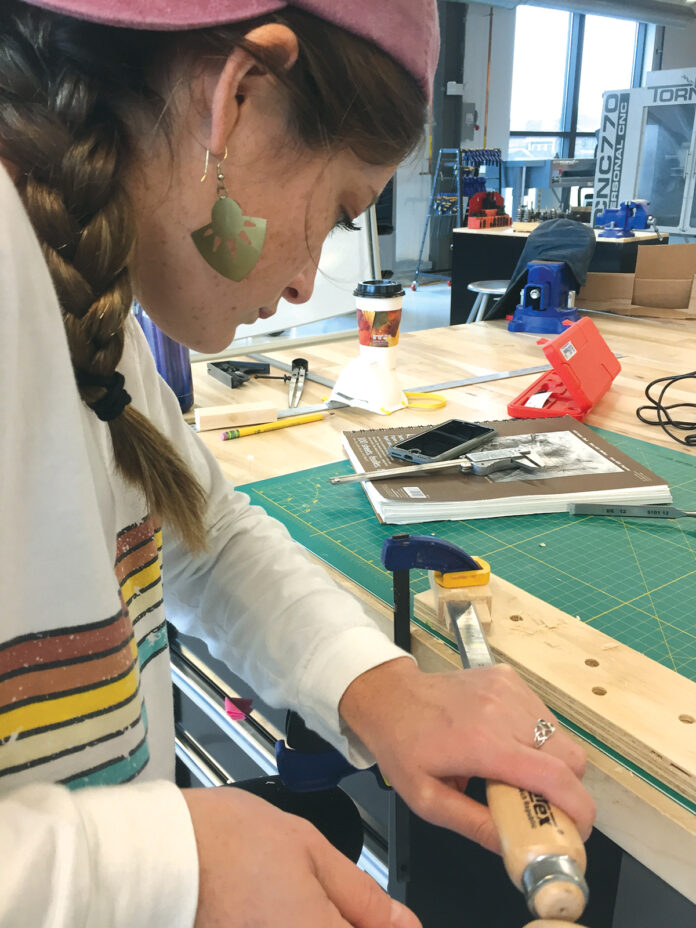
There is a big demand for young people in the manufacturing sector for sure. But some of those jobs are not about making products, they are about designing them, says Jessica David, executive vice president of strategy and community investments at the Rhode Island Foundation, which in 2013 funded the creation of DesignxRI, a nonprofit economic-development organization for the design sector. Its aim? Create opportunities for Rhode Island designers and design businesses, investing in talent and connecting designers with projects.
Lisa Carnevale, executive director at DesignxRI, said that while college is required for some design careers, many opportunities are available for people with certificates or through apprenticeships.
Jewelry designers, interior designers, graphic designers and furniture designers are all career paths one can pursue with apprenticeships, for instance, according to DesignxRI career information.
At V.H. Blackinton & Co., manufacturers of police and government insignia in Attleboro, Bryan Trout, production manager, said there are opportunities for designers with high school and non-college training in manufacturing.
At Blackinton, there are only a few design jobs, using software such as Adobe Photoshop. But there are opportunities spread throughout manufacturing firms in Rhode Island and Bristol County, Mass., he said.
“We would definitely be looking for someone out of a trade school,” Trout said.
Students with design interest and skill coming straight from high school would start working other production jobs to familiarize themselves with the products, he said. Eventually, they would be trained in design software.
“If you have a little bit of artistic background and a willingness to learn, we can teach you the [computer-aided design] software,” Trout said.
A more traditional path to a design career can involve college, although not everyone who chooses that route can say that it is a straight line. Take Rebecca Slater, design director at Blakely Interior Design.
“It’s been a wild journey,” Slater said.
The rigors of routine commuting between Rhode Island and a Massachusetts university sidetracked her. She left school in the winter of 2015, putting her studies on hold.
But, “I always knew that I wanted to do interior design,” Slater said.
She began looking for opportunities closer to home to keep learning, and that spring met Paul Paolino, head of the Rhode Island School of Design certificate program at the time. He told her she could pursue a certificate program at RISD instead of waiting to finish her degree.
Slater told Paolino she wanted to finish her certificate in a year, and using her previous credits and creative scheduling, she did.
During her studies, Slater met Janelle Photopoulos, who had begun pursing her own certificate in 2012 while simultaneously running her business, Blakely Interior Design.
Photopoulos had already spent 10 years in marketing for AT&T, and wanted to pursue design, but wanted to hone her design skills first.
She started her business at the same time, out of necessity, thinking the business would go slowly during her studies.
“In that time my business just took off,” Photopoulos said.
In 2017, Blakely Interior Design had $700,000 in revenue, and that’s expected to double this year, she said. The growing business required extra hands, but fortunately Photopoulos knew someone who could help. She invited Slater to take on some of the work.
Balancing the job and her studies worked out. Slater delivered her final studio project and first commercial project within a day of each other.
“That was four years ago,” Slater said.

While Slater’s career path into design is available to younger professionals, not many seem to be taking advantage of it. Most of the RISD certificate program students are older people with decades in the workforce looking to add to their skill set, said Francoise McAree, program manager for fine and applied arts at RISD.
“The majority of our students are in their 40s,” McAree said.
At the Metropolitan Regional Career and Technical Center in Providence, students explore similar, albeit less spontaneous, journeys. They are encouraged to pursue their interests and discover potential career paths through interaction with adults whose work interests them, said Joe Battaglia, director of curriculum and instruction.
One of the areas they can investigate is advanced manufacturing through the school’s partnership at Community College of Rhode Island’s new Knight Campus advanced-manufacturing lab, Battaglia said.
Some of that learning includes design, such as that involved in packaging and shipping, he said.
“We’re always trying to expand opportunities for students who can’t choose to go to college directly after high school,” Battaglia said.
“You can really make a decent living in manufacturing, in design,” said David, of the Rhode Island Foundation.
One such path, Carnevale said, is the IYRS School of Technology and Trades, through its Digital Modeling & Fabrication program that prepares students for careers combining design and advanced manufacturing.
At IYRS, students learn the fundamentals of product design and how to turn product design concepts into real-world objects. They learn CAD software, digital-design principles and how to prototype designs using 3D printers, laser cutters, CNC routers, mills and lathes.
Kim Norton-O’Brien, director of development and marketing at IRYS, said the trade school trains its certificate-wielding graduates through programs in wooden boat building, composite building, marine systems and electronic/3D modeling.
The school, established as a boat-building center in 1995, has since grown into a trade school, Norton-O’Brien said.
The boat-building program trains students in how to put together, or take apart, a boat, piece by piece. In composite building, students learn to use new high-strength, low-weight materials, such as Kevlar, to build products. Electronic-modeling students learn to use software 3D modeling to design and manufacture products. Marine systems students learn to design, build and repair the electronic and hydraulic systems for small yachts.
All of those programs require an innate design talent to build on, Norton-O’Brien said, making IYRS a good destination for designers seeking a path into the workforce aside from college. About 90% of IYRS graduates receive a job offer by the time they’ve earned their certificate, she said.
The IYRS alumni are part of the team building a 2021 America’s Cup vessel. “We think it’s the fastest boat that’s ever been built,” Norton-O’Brien said.
Jeff Elsbecker, lead instructor of digital modeling and fabrication, who also taught for 10 years at Wentworth Institute of Technology in Boston, said not many high school graduates know about IYRS, since the school has only been offering the new programs beyond ship building for the last three years. “It’s great for someone who has experience or aptitude that they want to give a turbo boost to,” Elsbecker said.
Also, he said, IYRS grads are well-equipped to land entry-level positions that provide a good quality of life. Elsbecker said graduates have gone on to apply their design skills working with youth education in science, technology, engineering and math, product development, custom manufacturing and CNC machining and 3D printing.
For aspiring designers, there are myriad opportunities if they’ve honed their skills, Elsbecker said.
“If they pursued it, they would find work in the field,” he said.












